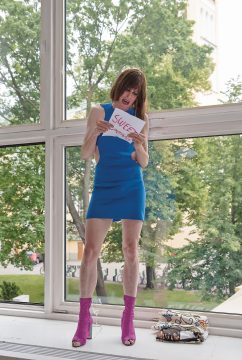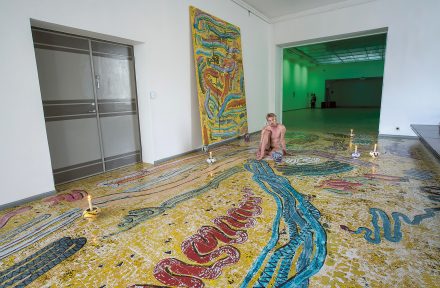The year 2018 marks the 13th occurrence of the Baltic Triennial, which, for the first time since it was established in 1979, takes place in all three Baltic countries. Until now the triennial was organized by the Contemporary Art Center (CAC) in Vilnius; this time, however, it is also commissioned by the Contemporary Art Center in Latvia and the Center for Contemporary Art in Estonia.
The thirteenth edition of the triennial is divided into three chapters, with one exhibition taking place in each of the Baltic capitals. The first chapter in the Contemporary Art Center in Vilnius, the second in Tallinn Art Hall and the closing chapter in Riga’s Kim? Contemporary Art Centre. In addition to the above mentioned three, the triennial also includes “Prelude”, an exhibition that took place in the CAC in Vilnius in September 2017 and an evening of performances and poetry entitled “Bastard Voices”, which occurred in the South London Gallery in March 2018.
The triennial brings together a group of over 70 artists and collectives, many of them from the Baltics, but there are a considerable number of international artists as well. From chapter to chapter these artists form constellations only to dissolve and find themselves coming together in new formations and new settings: some are present at all locations, and some just in a single one.
BT13 was conceptualized by an international team, with Vincent Honoré as the artistic director and Dina Akhmadeeva, Canan Batur, Neringa Bumbliene, Cédric Fauq and Anya Harrison as curators. The decision to involve an international curatorial team coincides with a recent trend of involving more international curators in the Baltic art scene. For example, only a few months prior to the triennial, its Estonian host, the Tallinn Art Hall, produced an extensive exhibition “The State is not a Work of Art”, curated by Katerina Gregos, also the chief curator of the first Riga Biennial (RIBOCA), currently showing in various locations in the Latvian capital.
The triennial’s title, “Give Up the Ghost” is centered around the question: what does it mean to belong at a time of fractured identities? As keywords, fragmentation, fluidity, hybridity, polyphony and multiplicity are often mentioned in the accompanying texts. The curatorial approach is, above all, intentionally poetic. Furthermore, by evoking such notions as “formless subjectivity, bastard objects and anti-categories”, the team strives to compose “a fluid score rather than the headlines of an activist manifesto.” Honestly, this is not a position I would really want to argue against: poetry can be vital to survival.
Often when the Baltics are discussed in terms of belonging, hybridity and fragmentation, it is in reference to the countries’ Soviet past. This, in turn leads to constructing progressive narratives of healing, recovering, overcoming hardship, etc. So, considering all that and the fact that this year Estonia, Latvia and Lithuania celebrate their 100th anniversaries of independence, I am relieved to see the centennial mentioned only in passing. As Honoré puts it, he saw an opportunity “not to think of this anniversary in a nostalgic manner, but as a chance to rethink our presence within the world.” Sure enough, when it comes to present, past or future identities, individual or collective, fragmentation and multiplicity are always at the core, and it makes sense to explore rather than try to mend. To paraphrase a recent book title: “Literally, show me a wholesome person” – and that is not a judgment: it’s stating a fact, you know? However, I still can’t quite seem to pinpoint what the ghost is that we are asked to give up.
Each of the chapters is ascribed a central theme: “belonging” to Vilnius, “citizenship” to Riga, and “body” to Tallinn. The Tallinn exhibition is curated by Dina Akhmedeeva, who presents a rather fragmented, “amorphous” image of the body to the audience. It is a disassembled body, a body that is described using material and measurable categories. As I stroll through the art hall, I think about the ghosts and bodies of the artists and their works, with my mind extending simultaneously through multiple temporal zones of the exhibition and questioning what/who is really present and what/who has already left: is what I see a body or a ghost?
The very first artwork introducing the exhibition to the visitor, Lina Lapelyte’s polyphonic sound-piece asking repeatedly “Where are my eyes?”, is almost too literal of an illustration of the curators’ statement. Lapelyte’s howls lead to Merike Estna’s painted ceramic space that transposes art onto a body and a body onto art. Her “An egg, a Larva, a Nymph” consists of a painted ceramic floor, vessels and a canvas, with a sitting naked performer added to the installation during the opening. Estna’s was one of the many performances that took place throughout the opening night. Others were by Paul Maheke, Young Girl Reading Group, Young Boy Dancing Group and Adam Christensen. Some of the performances are still present at the exhibition through related art objects/artifacts, while others have left behind almost no physical traces and now exist in the space as ghosts that many might not realize are actually there.
Coming back to bodies though, the summer heat, tangible in the exhibition spaces, actually worked well with the idea of fluid and fragmented bodies. It seemed as if everything was melting, with various body parts scattered around the art hall: Michael Dean’s black tongue, Nina Beier’s bodiless hair, and Derek Jarman’s shattered black paintings with assorted organic matter and teeth.
When looking at the darkly captivating work of Derek Jarman, an artist who died more than 20 years ago, the question of ghosts and bodies arises again. Sure, all bodies carry and make identities that are fractured and fluid in one way or another. It’s rarely, however, in the same manner: the composites of identities are very much situated in the particular time and space the body inhabits. I am still unsure what the ghosts of these bodies and once-bodies are anchored to, even if briefly, in the context of this exhibition. Just the same, I try to imagine what the ghosts of the French gender-bending artist Pierre Molinier and the Estonian Soviet dissident Ülo Sooster, standing side-by-side, could be saying to one another, beyond the depicted slick exposed thighs? In the context of this exhibition, I also have some difficulty fully grasping Hanna Black’s video “My Bodies”, a work I love and have probably watched countless times since its release in 2014, beyond its suggestion of the possibility of multiple bodies.
I love the poetic space the exhibition lays out, the “creole garden”, “a place of disorder”, as stated by Honoré, or a “body party” to which “no one is invited but you, baby”, as cooed by the R’n’B singer Ciara in Hanna Black’s video. Yet I kind of feel like I have been ghosted, not sure by whom, but they certainly left before telling me what the party is really about. The reluctance to actually name the ghost(s) could make them even more invisible: even in poetry there is importance in naming things.






